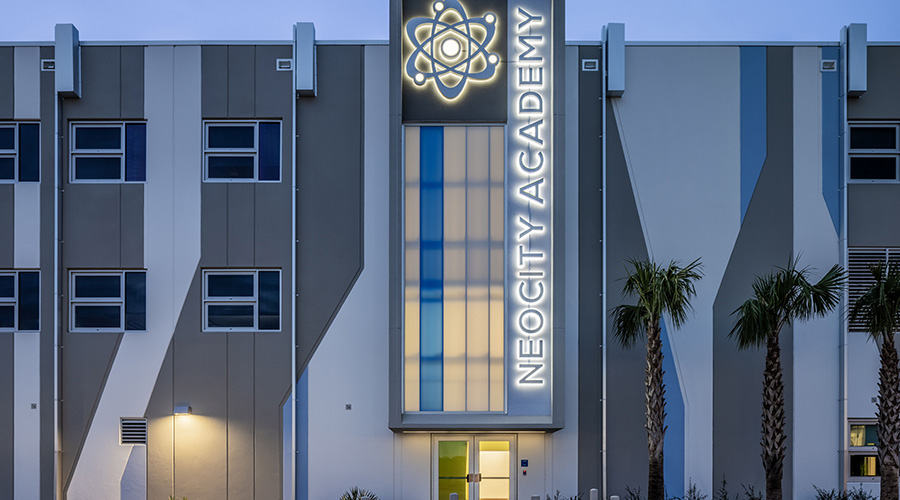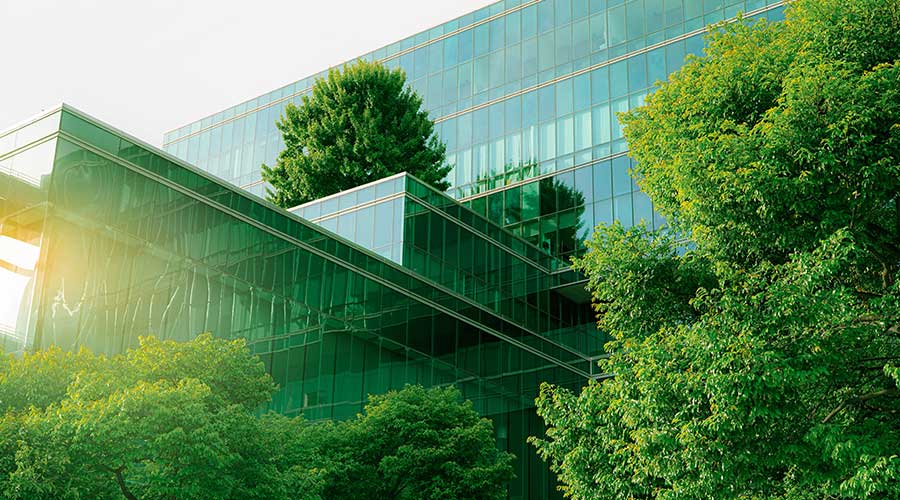Sustainable Design: Beyond Cost and Performance
More and more, green criteria factor into product selection. An environmental life-cycle assessment can help facility executives identify what’s important.
By Greg Zimmerman, Managing Editor
When it comes to product selection, even the most progressively green facility executive will probably agree that performance and cost are the most critical criteria. For many organizations, however, green criteria are becoming nearly as important for reasons ranging from the high cost of energy to upper management’s desire to use sustainability to bolster an organization’s image.
But what green criteria are important, and how should these criteria be weighted against one another, or against performance and cost? Is a product with high-post-consumer recycled content more green than one that was manufactured with a low embodied energy? Is paint with low VOC emissions better for the environment than regular paint manufactured by a company committed to reducing its carbon dioxide emissions?
“There is no magical answer,” says Don Reed, senior consultant at Ecos Corp., a firm that helps organizations match products with their green needs. “If all criteria are equal, the question is, how does the product rate on things that are important to the organization.”
Thus, the task of the facility executive: determining what is important for the organization and developing a plan to synchronize product selection with that vision. From green building rating systems, to green certifications, to guides for particular types of buildings, to tools for performing life cycle assessments, there are more tools now than ever to assist facility executives in identifying the criteria and products that meet their green needs.
Starting Green
If an organization is at the starting blocks of developing a green vision, the U.S. Green Building Council’s LEED rating systems can provide a good reference point for beginning to identify what is green and what’s not. Even though they were developed as tools for whole building green design, the LEED rating systems for new construction, existing buildings, commercial interiors, and core and shell also provide benchmarks for evaluating facets of products’ greenness, such as VOC emissions for paints and carpeting, and reflectivity and emissivity values for roofs.
Organizations can use LEED as a way to narrow down goals and begin an action plan for systematically selecting green products that match the organization’s burgeoning green goals. Charlotte-based Wachovia is an organization that falls into this category.
“We currently use LEED as a surrogate filter for product selection,” says Jeff Austin, vice president of corporate real estate, innovation and research. “Yet, recognizing that its strengths are in the areas of building design and construction, rather than product evaluation, we’ve augmented LEED with our own external performance criteria. Our targets are in excess of code for energy and water use, and we have high materials and resource standards as well.”
Wachovia is building a new high-rise headquarters in Charlotte it intends to be LEED-certified. The company is also at work on a prototype green bank branch. Both of these projects are the guinea pigs for the company’s future sustainable goals. “It’s fair to say these projects will help us develop green standards for the portfolio,” says Austin.
Austin says LEED helps the company make product selection decisions based on its commitment to the “triple bottom line.” This means evaluating the implications of product selection (and every action taken, really) economically, environmentally and socially.
The company has created a matrix that weights different product criteria when sending RFPs to vendors. The idea is to make sure that the company will find the highest quality product at the best total cost of ownership from a supplier that meets the company’s criteria, environmental and otherwise.
“Suppliers are weighted based on cost and other things that are driving our business,” says Robert Steen, vice president of financial services, procurement. “We give suppliers a chance to meet our triple bottom line.”
Wachovia also considers a product — in one case, furniture — more favorably if it has gone through a formal green certification, like Green Seal or Greenguard. These third party certifications, or eco-labels, are useful tools for verifying performance on specific environmental criteria, such as VOC emissions.
“Green certifications are important because they give facility executives a relatively easy way to rate products,” says Reed. “The green certifications say that, on balance, certain products are environmentally superior based on specific standards.”
Vision for Sustainability
LEED is also an important benchmark for Emory University, which has committed to building all new buildings to a minimum of a LEED Silver certification. However, as the university writes standards for product selection to match its overall sustainable vision, the search for replacement products has a decidedly green tinge as well.
“The first question we ask is, ‘Is it environmentally friendly?’” says Bob Hascall, vice president of campus services. “If the answer isn’t ‘yes,’ that’s the end of the conversation.”
One of the main selection criteria for Emory is how “safe” a product is. Hascall explains that this means that Emory looks for products that are “safe for the environment, safe for our employees, and safe for our students.”
Other criteria for Emory, in addition to meeting LEED standards, include: low VOC emissions, which is important at an academic institution; durability, because Emory’s buildings are expected to last more than the 50-year average for most buildings; and maintainability, so that operational costs are kept reasonable. Hascall says he also gives an edge, all things being equal, to products manufactured in or near Atlanta and products with high recycled content. All of these goals are spelled out explicitly in Emory’s “Sustainability Vision,” a document developed with the input of staff from all walks of campus life. The university also commits itself to the triple bottom line, and aspires to be a leader for other institutions that wish to develop similar green goals.
For Oakland, Calif.-based health care giant, Kaiser Permanente, matching building products with the organization’s environmental vision is also a task of utmost importance. However, Kaiser Permanente doesn’t use LEED as a guide, says Thomas Cooper, Kaiser Permanente’s program lead, design and construction standards and chair of the company’s high-performance building committee. The reason: LEED doesn’t take into account a hospital’s unique energy, waste and indoor air quality requirements.
So Kaiser Permanente has developed its own environmental purchasing policy, based partly on California’s 01350, a stringent indoor air quality standard developed by the California Cooperative for High Performance Schools (CHPS). Kaiser Permanente was also instrumental in the development of the Green Guide for Health Care standard, a LEED-like tool tailored specifically for health care organizations.
But where Kaiser Permanente separates itself from the pack is the way it examines the environmental track records of product suppliers when it awards national purchasing agreements. (See sidebar)
“We have a series of questions we ask manufacturers directly,” says Cooper. “These address both levels of green — green performance and green manufacturing. We consider raw materials, chemical composition, what happens to the waste, carbon dioxide emissions, VOC emissions in use, and end-of-use strategies.”
Life-cycle assessment
The so-called second level of green — an environmental life-cycle assessment that evaluates the way a product is manufactured, and ultimately disposed of or recycled — is part of the next wave of green evaluation, according to many green building experts. Because performance and cost are usually the overriding criteria, it’s often difficult to get organizations to invest, both financially and emotionally, in what a manufacturer does to a product before and after it’s actually installed in a building.
In 1998, President Bill Clinton issued Executive Order 13101, which instructed the U.S. Environmental Protection Agency to develop guidelines for environmentally preferable purchasing — essentially, greening the government. EPA established 12 environmental impacts, which now form the basis of most product-related environmental life-cycle assessments.
“Life-cycle assessment is the future of product evaluation,” says Rob Watson, senior scientist with the Natural Resources Defense Council, and a member of the board of directors for USGBC and the International Design Center for the Environment (IDCE). “Life-cycle assessment means looking at the whole life cycle.”
An environmental life-cycle assessment is different than a life-cycle-cost analysis or assessment. In the environmental sense, a life-cycle assessment, according to IDCE, “provides a science-based measurement of a product’s environmental impacts throughout its life cycle, from raw materials sourcing through manufacture, shipping, use and re-use or end-of-product life phases.”
Life-cycle assessment tools
There are a couple tools facility executives can use to perform environmental life-cycle assessments, and one new one that will be available soon.
Building for Environmental and Economic Sustainability (BEES) is a downloadable program developed by the National Institute of Standards and Technologies (NIST) with support from EPA. The program weights EPA’s 12 environmental impacts, combines that data with a life-cycle cost analysis based on an ASTM standard, and provides users with an overall performance measure in an easy-to-read bar graph. Until recently, BEES had just estimated the environmental impact of generic product types, like carpeting or roofing; however, the newest version of BEES (BEES 3.0) incorporates more than 200 building products, including 80 brand-specific products. BEES is sometimes used as a reference tool, rather than being made part of a specification, because its formula for weighting environmental impacts may assign too much or too little value to a specific criteria. BEES can be downloaded for free.
The Athena Institute’s Environmental Impact Estimator is a life-cycle assessment tool specifically designed for structural systems, like steel and concrete. Facility executives can instantly see the environmental impacts of their design in areas including embodied primary energy use, global warming potential, solid waste emissions, air and water pollutants, and natural resource use. The software is available for purchase.
The International Design Center for the Environment has developed a suite of tools called eLCie. Like BEES, eLCie is based on EPA’s environmental impacts. However, eLCie is different in that it has a component for manufacturers to input their own data and an end-user component — eLCie Online — that helps facility executives identify which products can best match the environmental goals of their organizations.
Instead of a bar graph, eLCie provides layered information on product life-cycle assessment results, ranging from a full report to a spidergram. The spidergram allows users to compare the environmental footprint of a product against the industry average. Each EPA impact is weighted equally in eLCie, so users can see how the product scores with the impacts judged most important by their organizations.
“We’ve tried to make eLCie user-friendly while being scientifically robust,” says Deborah Dunning, IDCE’s president and founder. “To be in eLCie Online, a product’s performance will have to be 20 percent better than industry average. We begin with a baseline created by integrating the most current, peer-reviewed datasets with the data we collect from manufacturers, certified as complete and transparent by a life-cycle assessment practitioner. We then compare all like products against the relevant baseline.”
The eLCie Industry Wizard is the manufacturer component of eLCie. It is essentially an industry-specific questionnaire manufacturers can use to input data on their products.
“Manufacturers get to see their product life-cycle assessment results before anyone else,” says Dunning. “They can use the eLCie Industry Wizard for product design and improvement, doing ‘what if’ scenarios to determine which raw materials and processes will to lessen the product’s environmental impacts.”
This process is currently underway for the first product type — carpeting. The next step — coming this fall for carpeting — will be IDCE certifying the manufacturers’ product data as complete, comparable and transparent. The products will then be rated on each of the 12 EPA environmental impacts, using a tool from EPA. The resulting performance score shows the product’s environmental performance relative to industry average.
This process will continue with all frequently purchased building product types. Dunning says many manufacturers are eager to participate because they recognize that the eLCie tools will help them increase the sustainable features of their products.
Those that have worked diligently on eLCie are excited about its potential. “eLCie is going to do for product specification what LEED did for green building,” says Watson.
Of course, the ultimate goal of green building advocates is combining green product selection and green design. A tool for integrating green design with green product specification may be available in the not-too-distant future. Experts expect that environmental life-cycle assessment will be a major change injected throughout the next version of LEED for new construction. While there’s no specific timetable for the release of LEED-NC 3.0, it is probably at least two years away.
Greening the supply chain
For now, facility executives planning to incorporate environmental life-cycle assessments into product selection still need some justification, cost or otherwise.
“Environmental life-cycle assessments have a host of cost impacts,” says Kaiser Permanente’s Cooper. “What does it cost to maintain? What chemicals are needed to clean it? Are they hazardous? What happens while we’re using them? The key is finding the intersection between life-cycle assessments and cost impact. That’s where the justification can be made.”
One reason for performing an environmental life-cycle assessment is essentially to build green criteria into every step of an organization’s building product supply chain. Kaiser Permanente has developed its own life-cycle assessments tool, and Wachovia’s Austin says the company will include life-cycle assessments in its soon-to-be-developed green product selection standards. In fact, Wachovia has provided financial backing for the development of eLCie.
Even though environmental life-cycle assessment is still far from a mainstream practice, it’s making headway. “We’re on the cusp,” says Watson. “Consumers are going to continue demanding certain things and markets are going to continue to develop. All these ideas are going to continue gaining currency.”
Buying Green in the Real World
Kaiser Permanente has developed an environemental procurement policy that applies to its national puchasing agreements. Under that policy, the nation’s largest HMO or health maintenance organization has identified factors that make an alternative preferable:
- Reduces consumption
- Conserves resources (e.g., uses less water, energy or virgin resources to produce or use; has Energy Star rating)
- Eliminates or reduces waste
- Reduces toxicity (e.g., no chlorine)
- Can be recycled
- Offers competitive functionality and effectiveness
- Offers competitive total cost of ownership (including unit cost, cost of waste,etc.)
The health care giant has also developed specific environmental criteria for all purchasing decisions. For example, Kaiser seeks to avoid products containing:
- Persistent bioaccumulative toxic compounds (defined in an addendum to the policy)
- Carcinogens, mutagens and reproductive toxic chemicals (defined in an addendum to the policy)
- Mercury
- Phthalates (e.g., plasticizer DEHP — di-2-ethylhexyl phthalate)
- Polyvinyl chloride (PVC)
- Brominated flame retardants
Kaiser also promotes the purchase of building products, materials and furnishings that have the following characteristics:
- No adverse affect on indoor air quality
- Approved by National Facilities Services Planning & Standards
- High post-consumer recycled content
- Readily recycled, reprocessed or reused
- Latex-free
- No or a reduced amount of toxins
- Products that have “Take Back” provisions (i.e., products are returned to vendors after life to be disposed of in an environmentally friendly way)
- Chlorine-free paper products
|
Green Product Characteristics
The majority of green products have one or more of the following health or environmental attributes:
- They promote good indoor air quality (typically through reduced emissions of VOCs and/or formaldehyde)
- They are durable and have low maintenance requirements
- They incorporate recycled content (post-consumer and/or post-industrial)
- They have been salvaged from existing or demolished buildings for reuse
- They are made using natural or renewable resources
- They have low “embodied energy” (the energy required to produce and transport materials)
- They do not contain ozone-depleting substances
- They do not contain highly toxic compounds, and their production does not result in highly toxic by-products
- They are obtained from local resources and manufacturers
- For wood or bio-based products, they employ “sustainable harvesting” practices
- They can be easily reused (either whole or through disassembly)
- They can be readily recycled (preferably in a closed-loop recycling system)
- They are biodegradable
Source: Whole Building Design Guide — a Web portal that offers a wide range of information on high-performance buildings. The Web site is made available by the National Institute of Building Sciences (NIBS). This list is drawn from an article by John Amatruda of Steven Winter Associates.
|
Environmental Impacts
The EPA identified 12 environmental impacts to help define environmentally preferable products. These items form the basis of most life-cycle assessments.
1. Global warming
2. Acid rain
3. Water pollution
4. Fossil fuel depletion
|
5. Indoor air quality
6. Habitat alteration
7. Ozone depletion
8. Water intake
|
9. Air pollution
10. Smog
11. Ecological toxicity
12. Human health |
|
Product Impact at a Glance
The graph below, known as a spidergram, is used in the eLCie environmental life-cycle-assessment tool to provide a quick way to see a product’s environmental impact. Each spoke of the diagram shows a specific impact. The outer ring represents the industry average performance. Each spoke shows whether the product has more or less impact than the industry average. On the spidergram shown below, the hypothetical product is rated 100 percent of industry average impact for water use, but less than the industry average for global warming.

|
Related Topics:












